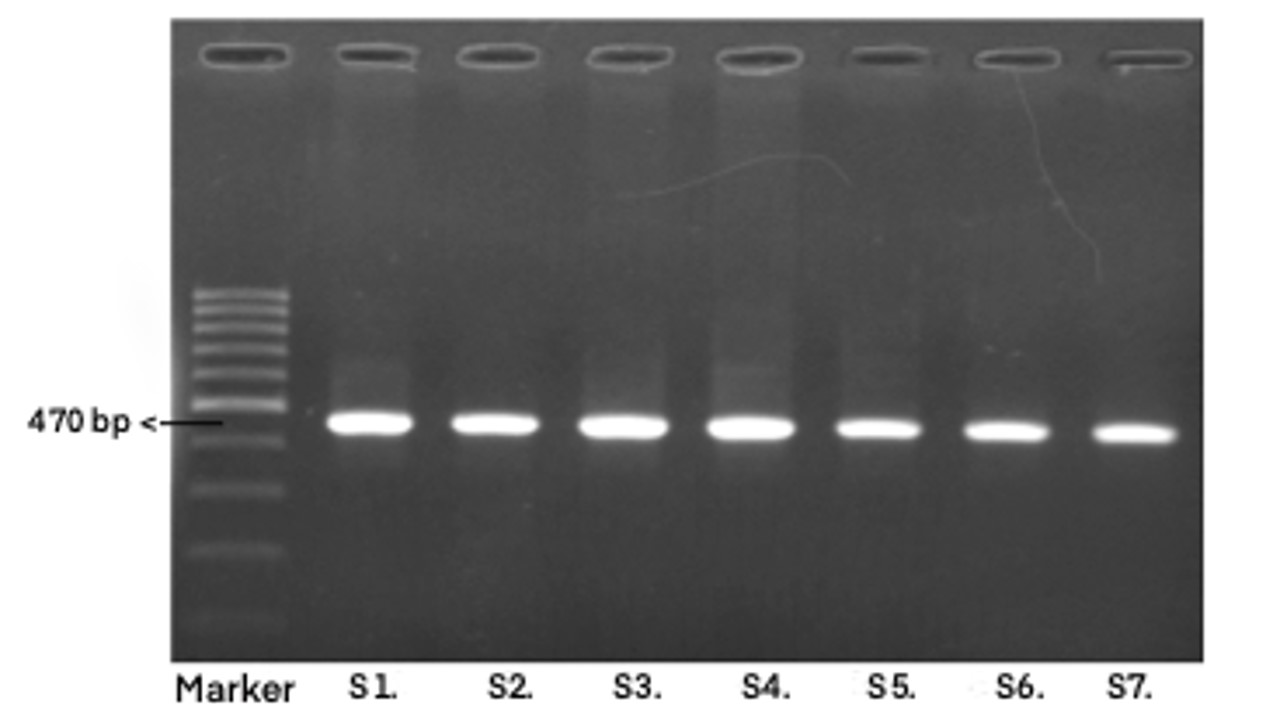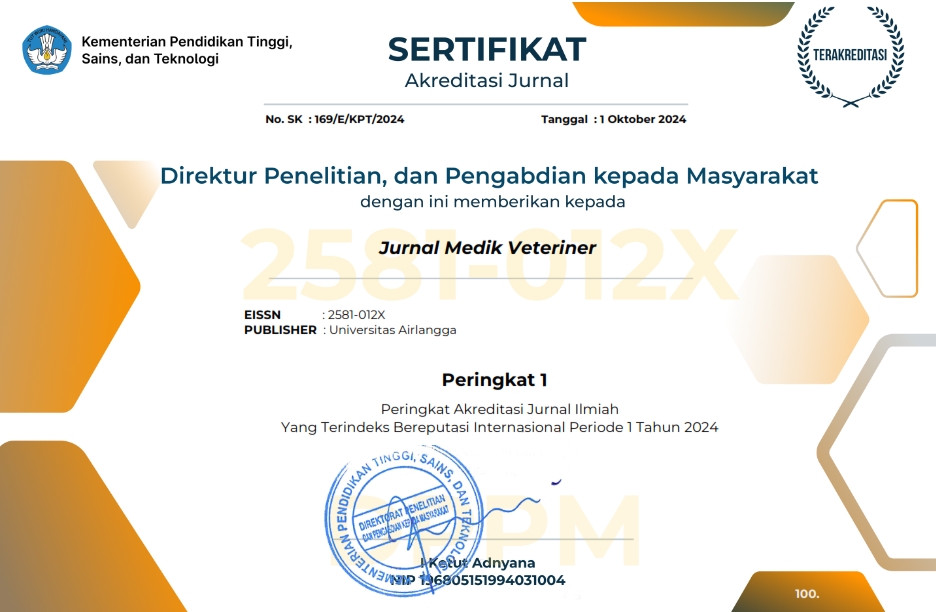Exploring the Relationship Between Growth Hormone Secretagogue Receptor (GHSR) Gene and Body Proportions in Bangkok Chickens: Insights from DNA Sequencing and Hin6I Enzyme-Restricted PCR-RFLP Analysis

Downloads
The purpose of this study was to determine the diversity of the growth hormone secretagogue receptor (GHSR) gene and also to analyze the association of the GHSR gene with the body proportions of Bangkok chickens. A total of 125 Bangkok chickens were reared, and blood samples were taken. Bangkok chickens were kept in colony cages with ad libitum feeding and drinking. The GHSR gene polymorphism was determined using the PCR-RFLP method. The restriction enzyme used in this study was Hin6I. The data analyzed were indicators of body proportions, which included data on body weight, carcass weight, and commercial cut weight. Single nucleotide polymorphism (SNP) identification using the Molecular Evolutionary Genetics Analysis 7 program with reference number AB095994.1. Allele frequency values, genotype frequencies, and Hardy-Weinberg balance values were also analyzed. The association between the GHSR gene and the traits observed in Bangkok chickens was analyzed using the T-test. The results of the study showed that the GHSR gene in Bangkok chickens had two genotypes, namely TT and CT. The values for Ho and He were 0.224 and 0.198, respectively. The genotype frequencies of TT and CT were 0.776 and 0.224, respectively. The two genotypes were associated with body weight, carcass weight, and commercial weight (p < 0.05). For all measured criteria, the TT genotype showed a higher weight value than the CT genotype. The GHSR gene has the potential to be used as a genetic marker for the selection process on body weight, carcass weight, and commercial weight traits.
Allendorf, F. W., Luikart, G. H., & Aitken, S. N. (2012). Conservation and the genetics of populations. John Wiley & Sons.
Badaruddin, R., Astuty, F., & Pagala, M. (2017). Performa Penetasan Telur Ayam Hasil Persilangan Ayam Bangkok Dengan Ayam Ras Petelur. JITRO, 4(2).
El-Magd, M. A., Saleh, A. A., Abdel-Hamid, T. M., Saleh, R. M., & Afifi, M. A. (2016). Is really endogenous ghrelin a hunger signal in chickens? Association of GHSR SNPs with increase appetite, growth traits, expression and serum level of GHRL, and GH. General and Comparative Endocrinology, 237, 131–139.
Fang, M., Nie, Q., Luo, C., Zhang, D., & Zhang, X. (2010). Associations of GHSR gene polymorphisms with chicken growth and carcass traits. Molecular Biology Reports, 37, 423–428.
Fikri, F., & Purnama, M. T. E. (2020). Biosecurity Application of Small Scale Chicken Abattoir in Sidoarjo, East Java, Indonesia. Systematic Reviews in Pharmacy, 11(6), 226–229.
Hall, T. A. (1999). BioEdit: a user-friendly biological sequence alignment editor and analysis program for Windows 95/98/NT. Nucleic Acids Symposium Series, 41(41), 95–98.
Hijriyanto, M. (2017). Pengaruh frekuensi penampungan semen terhadap kualitas spermatozoa pada Ayam Bangkok. Jurnal Ilmiah Mahasiswa Veteriner, 1(1).
Jin, S., Chen, S., Li, H., Lu, Y., Xu, G., & Yang, N. (2014). Associations of polymorphisms in GHRL, GHSR, and IGF1R genes with feed efficiency in chickens. Molecular Biology Reports, 41, 3973–3979.
Kaczor, U., Poltowicz, K., Kucharski, M., Sitarz, A. M., Nowak, J., Wojtysiak, D., & Zieba, D. A. (2016). Effect of ghrelin and leptin receptors genes polymorphisms on production results and physicochemical characteristics of M. pectoralis superficialis in broiler chickens. Animal Production Science, 57(1), 42–50.
Kartikasari, A. M., Hamid, I. S., Purnama, M. T. E., Damayanti, R., Fikri, F., & Praja, R. N. (2019). Isolation and Identification of Escherichia coli as Bacterial Contamination in Broiler Chicken Meat in Poultry Slaughterhouse Lamongan District. Jurnal Medik Veteriner, 2(1), 66–71.
Kojima, M., & Kangawa, K. (2005). Ghrelin: structure and function. Physiological Reviews, 85(2), 495–522.
Lei, M., Luo, C., Peng, X., Fang, M., Nie, Q., Zhang, D., Yang, G., & Zhang, X. (2007). Polymorphism of growth-correlated genes associated with fatness and muscle fiber traits in chickens. Poultry Science, 86(5), 835–842.
Muryanto, H. P., Herman, R., & Setijanto, H. (2002). Evaluasi Karkas Hasil Persilangan antara Ayam Kampung Jantan dengan Ayam Ras Petelur Betina. Journal Animal Production, 4(2), 71–76.
Nassiry, M. R., Javanmard, A., & Reza, T. (2009). Application of statistical procedures for analysis of genetic diversity in domestic animal populations. American Journal of Animal and Veterinary Sciences, 4(4), 136–141.
Nataamijaya, A. G. (2010). Pengembangan potensi ayam lokal untuk menunjang peningkatan kesejahteraan petani. Jurnal Litbang Pertanian, 29(4), 131–138.
Niarami, D. M., Masoudi, A. A., & Vaez Torshizi, R. (2014). Association of single nucleotide polymorphism of GHSR and TGFB2 genes with growth and body composition traits in sire and dam lines of a broiler chicken. Animal Biotechnology, 25(1), 13–22.
Nie, Q., Fang, M., Xie, L., Peng, X., Xu, H., Luo, C., Zhang, D., & Zhang, X. (2009). Molecular characterization of the ghrelin and ghrelin receptor genes and effects on fat deposition in chicken and duck. BioMed Research International, 2009.
Ningsih, N., Syaikhullah, G., Adhyatma, M., Rofiqi, Z., & Al Huzaini, M. F. (2022). The effect of phytobiotics ginger (Zingiber officinale Rosc.) extract in drinking water on hematological characters of KUB chickens. IOP Conference Series: Earth and Environmental Science, 980(1).
Perdew, G. H., Vanden Heuvel, J. P., & Peters, J. M. (2006). Regulation of gene expression: molecular mechanisms. Springer.
Ronny Rachman Noor. (2010). Genetika Ternak. Penebar Swadaya.
Sambrook, J., & Russell, D. W. (2001). Molecular Cloning: Ch. 8. In Vitro amplification of DNA by the polymerase chain reaction (Vol. 2). Cold Spring Harbor Laboratory Press.
Syaikhullah, G., Darwati, S., & Sumantri, C. (2017). Asosiasi Keragaman Growth Hormone Secretagogue Receptor (GHSR| Hin6i) terhadap Bobot Karkas Ayam Kampung pada Umur 12 Minggu. Jurnal Ilmu Produksi Dan Teknologi Hasil Peternakan, 5(3), 117–121.
Tschöp, M., Smiley, D. L., & Heiman, M. L. (2000). Ghrelin induces adiposity in rodents. Nature, 407(6806), 908–913.
Wardhana, D. K., Haskito, A. E. P., Purnama, M. T. E., Safitri, D. A., & Annisa, S. (2021) Detection of microbial contamination in chicken meat from local markets in Surabaya, East Java, Indonesia. Veterinary World, 14(12), 3138–3143.
Wardhana, D. K., Purnama, M. T. E., Kean, O. H., & Tyasningsih, W. (2019). Detection of salmonella on chicken meat using immunomagnetic separation and conventional methods from traditional market in Surabaya, East Java, Indonesia. Indian Veterinary Journal, 96(11), 31–33.
Copyright (c) 2024 Gayuh Syaikhullah, Rosa Tri Hertamawati, Muhammad Adhyatma

This work is licensed under a Creative Commons Attribution-NonCommercial-ShareAlike 4.0 International License.
Authors who publish in this journal agree to the following terms:
1. The journal allows the author to hold the copyright of the article without restrictions;
2. The journal allows the author(s) to retain publishing rights without restrictions;
3. The legal formal aspect of journal publication accessibility refers to Creative Commons Attribution-NonCommercial-ShareAlike 4.0 International License (CC BY-NC-SA).






11.jpg)




















